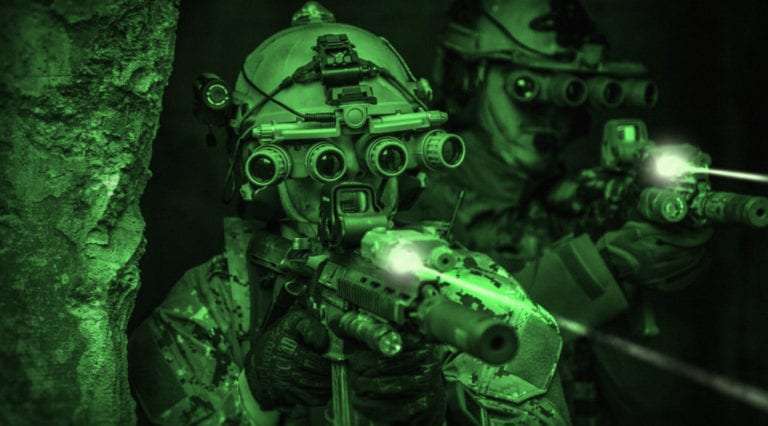
Wondering why night vision is always green?
I did too!
Keep reading to find out why night vision goggles and scopes turn shadowy figures into little green men!
How does night vision work?
Night vision technology works by amplifying ambient light in the environment from natural sources (think moon, stars, etc.) and man-made sources (street lights, security lights, etc.) and displaying that to your eye. Night vision goggles are made up of three main components. The night vision goggles are made up of a lens, an image intensifier tube, and an infrared sensor that uses two-dimensional sensors to increase the night vision by collecting more light.
Why is night vision green?
Most night vision is green because night vision scopes use phosphors to produce a green glow instead of using colors like red or blue.
Green was chosen because the human eye more easily distinguishes levels of green light. So, it’s easier to pick out targets and shapes with less green light.
Are there other colors used in night vision?

While night vision technology is mostly green other night vision technologies use different colors. Forward-Looking Infrared (FLIR) cameras, for example, typically use pastel hues of red and white because it’s easier to see the difference between objects in those two colors than it would be if everything was green.
Thermal imaging is another type of night vision that generally produces white images for warm objects on a black background.
What about thermal imaging?
Thermal imaging is night vision for the rest of us. It’s also a type of night vision that doesn’t require green phosphors to work, so it can be used in other environments like water and snow. But what exactly does thermal imaging do? How does it work? And why is night vision always green if there are other technologies out there that don’t use green light? Keep reading!
How does thermal imaging work?

Thermal imaging cameras detect infrared radiation emitted by objects around them. This includes heat signatures given off by living organisms (like you!), warm rocks on a cool winter night, or even cold surfaces with an abundance of moisture (think fog!). Thermal imagers then display this information as different colors depending on the temperature detected; reds indicate hotter temperatures while blues signify
Is thermal imaging better than night vision?
When there is no source of ambient light, night vision is not very effective. In those cases, thermal imaging is king.
Thermal imaging night vision is great for finding out what’s going on around you, even when it’s pitch black outside! Traditional night vision goggles are not as effective in low-light situations because they depend on ambient light to work properly. Thermal night vision cameras use heat signatures instead of ambient light so things that give off higher amounts stand out on the display.
Planning on hunting at night? The best thermal scope guarantees a fruitful hunt!
Which is the best type of night vision?

Both night vision and thermal night vision have their strengths and weaknesses.
While night vision is mostly green, it works well in low-light situations and doesn’t need to be charged or powered on like other kinds of night vision technology. Thermal night vision cameras give you the best look at things that are happening around you even when there isn’t any ambient light.
